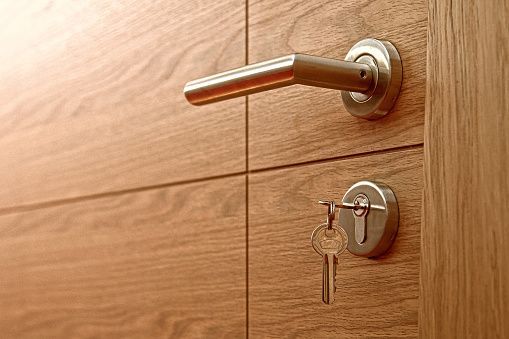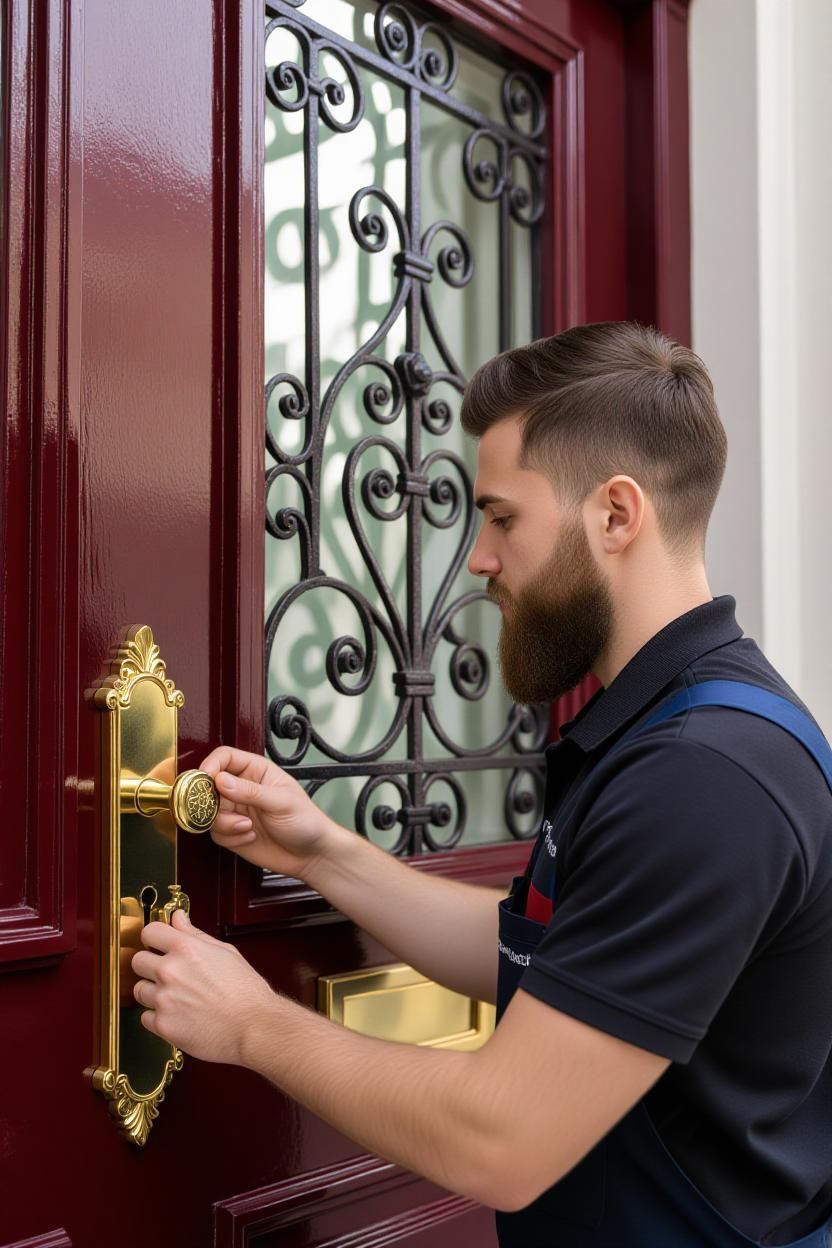Euro cylinders - What are they?
July 29, 2025
What are euro cylinders and what do they do?
A Euro Cylinder lock or pin tumbler lock, which was its original description when 1st patented in 1805, is used primarily as a locking medium to operate a lock case with a euro shaped hole.The standard Euro Cylinder is the most common cylinder lock available widely from DIY stores including the majors plus high street shops specialist retailers and locksmiths.
The Euro Cylinder is located through the lock case and secured by a fixing screw through the face of the lock case. The key rotates a cam which in turn drives the deadbolt in the lock case into a prepared keep in the frame of the door thus securing the door in place. Or in the case of UPVC doors, will activate the mechanism inside the door and not allow the handle to go down.
Euro Profile cylinder locks are by far the most popular means of locking todays modern homes and very many commercial sites including schools academies and hospitals to name a few. Euro Cylinders are very versatile hence their popularity amongst Locksmiths and Architectural Ironmongers. They can also easily be equipped with Thumbturns that can operate the cylinder from within - without the need for a key, safe to escape in case of a fire. (BS 3621/PAS 3621)
Typically the Euro Profile Cylinder or Lock Barrel as it is sometimes referred come in a variety of lengths typically 35mm to 40mm for single or half Euro Cylinder locks and 70mm up to 120mm as standard length Euro Cylinders in equal lengths either side of the central cam, for example a 70mm length standard Euro Profile Cylinder lock will measure 35mm either side of the operating cam . And an 80mm will be 40mm either side of the cam and so on. There also sizes that come in odd, a 90mm cylinder can be 40mm one side and 50mm the other, these typically come in UPVC doors.
Euro Lock types
So we have Anti Drill Euro Cylinders and anti drill and anti pick Euro Cylinders. Keen to be one step ahead of those seeking to burgle us the industry introduced British Standards to encourage manufacturers of Euro Cylinder Locks to improve not only their reliability but also its actual security level. CE marked is a necessity to prove the product is fit for function, however BSI Kitemarked products have been through additional tests ensuring locks can stand up to common forms of attack.
This standard ensures minimum levels of reliability and degrees of security depending on the standard achieved during testing.
The latest level of cylinder security is the British Standard Kite Mark TS* cylinders rated 1-3. 1 being the basic level and 3 at the time of writing being the highest level. A 3 star cylinder now offers, Anti Drill; Anti Pick; Anti Bump and Anti Snap. This does not however guarantee key security as some of the manufacturers have made their Kite Marked Euro Profile cylinders on a standard keyway where key blanks are available a key bars and locksmiths. However most will also come with patented keyways thus ensuring you are the only holder of the keys.
Parts of a Euro cylinder
- Core(s) – As with most locks in London the keyways are often quite restrictive. Often they have paracentric keyways, which means that the wards on face extend past the center of the keyway. On the other hand, some have very wide rectangular keyways. Cylinder locks do not have particular internal mechanisms. The cores often have pin tumbler or dimple configurations, but there are exceptions.
- Revolving Cam – They are often made of a hard plastic or metal. An actuator or cam is a rotating piece on the lock that the key manipulates. The cam, in turn, moves the lock bolt or activate the mechanism. Some euro profiles are even designed to only work on one side at a time, so two people cannot open the lock simultaneously. Too much pressure or wear can damage the cam. If the cam slips, that means that it is misaligned, so that the key is retained while trying to lock it. Technically the device might lock, but it will need to be unlocked to remove the key.
- Fixing Hole – A gap that allows the cylinder to be fastened inside the door. The fixing screw is inserted into the door with the lock in place, and this secures the device. This gap in the metal of the lock comprises the strength of the lock as well as secure it in place. When it is pressured this perforation will cause the lock to fail.
- Lock Body – On the Euro profile, there is a rectangular gap in the body where the cam is placed. Two C-clips keep the cam in position. This gap, along with the fixing hole leaves very little metal remaining to keep the device together. The gap separates two different cores that can be keyed alike or differently.
- High Security Additions – These can include sacrificial weak points, stainless steel pins (anti drill protection), etc. Anti-snap cuts do not truly prevent snapping. What they do is provide sacrificial points where the device can snap and leave enough of the lock in working order, so the security is not compromised. Anti-drill protection can often include a spinning disk on the front to prevent the drill bit gaining traction.
Weaknesses that may occur in a euro cylinder
Lock Snapping
We give a longer breakdown of the process here. In short simply access the protruding end of a Euro cylinder and grip it with a tool or mole grips. Shake the lock until it snaps in half. Remove the lock. Access the mechanism or case and open the door. The weak point in Euro Cylinders is the metal right beneath the fixing hole. Exerting severe pressure on the cylinder will break the lock in half. Once the lock is broken, the door can be opened very easily.
The best way to prevent snapping is by buying anti-snap locks or by having the cylinder flush against the door. If it is at all protruding the lock can be snapped. That is the reason for the term “lock snapping”. With anti-snap cylinders the lock will snap in a way that does not compromise the lock’s security and keeps the cam covered by at least half the pins. All BSI Kitemarked cylinders that are up to date will provide anti snap features.
Drilling a euro cylinder
Be careful if you choose to drill these types of locks. If you drill too far into the lock you will break the actuator. Once the actuator is broken, the lock will not work, even with the key. Once the actuator is broken the lock will need to be removed. This will be quite difficult if the lock is anti-snap. If the lock cannot be snapped, and the actuator has broken, the price of getting into the house compounds with the price of installing a new door. Drilling a lock is always the last resort, whoever is drilling the lock needs to keep a count of how many pins they are hitting.
If you need to contact a locksmith for more advice just head here.

If you live in Wimbledon’s SW19, you know the vibe - gorgeous tree-lined streets, the buzz of the Wimbledon Tennis Championships, and the charm of the Village or Common just a short walk away. But between the stunning Victorian houses, sleek modern flats, and lively shops on the high street, there’s a catch: lockouts after a late night cheering at the All England Club or the odd break-in, in quieter spots can throw a wrench in your day. Even thing like moving homes or updating your home insurance can come with challenges. That’s when you need a local locksmith you can count on to sort things out fast. At SMS Locksmiths, we're proud to serve Wimbledon and the SW19 area (including Southfields, Merton Park, and Colliers Wood) with 24/7 emergency and planned services. Our DBS-checked, fully insured technicians arrive within 30 minutes, using non-destructive methods and transparent pricing - no hidden fees or call-out charges. Whether you're a homeowner securing your Edwardian semi-detached or a business owner in the Wimbledon Broadway retail hub, we're here to keep you safe. In this guide, we'll cover the top 5 locksmith services we provide to SW19 residents, tailored to local needs like upgrading heritage locks or handling post-match rush lockouts. Read on for practical tips, and remember: prevention is key to peace of mind. 1. Emergency Lock Opening: Back Inside in Minutes, No Damage to basic locks Nothing disrupts a Wimbledon evening stroll like realising you're locked out - keys forgotten after a coffee at Gail's or a tennis viewing party. Our lock opening service gets you back in fast using advanced pick-and-decode tools, bypassing tools and years of skill and experience, avoiding costly door damage. • Why Wimbledon residents love it: SW19's mix of old sash windows and modern uPVC doors means quick, non-destructive entry is essential. We handle everything from front doors to sheds and post boxes without a trace. • Real-life example: A local family in Southfields called us at 10 PM after misplacing keys during a dog walk on the Common. We arrived in 25 minutes, opened the lock in under 10, and advised on a spare key safe. • Pro tip: Always keep a copy of your keys with a family member or a person you trust, but call us immediately for lockouts - DIY attempts often lead to bigger bills. No matter the time, our 24/7 team ensures you're not stranded. Customer review: "SMS saved our night - professional and stress-free!" – Wimbledon Village resident (5 stars on Trustpilot). 2. Lock Changing: Fresh Security for New Starts in SW19 Moving into a charming Wimbledon flat or after losing keys? A lock change is your first line of defence against unknown access. We replace old locks with high-quality, British Standard (BS3621) compliant options that meet insurance requirements. • Tailored for Wimbledon: Many SW19 homes have outdated rim locks on period properties; we swap them for secure euro cylinders or deadbolts that fit seamlessly. • The process: On-site assessment (free quote), removal of old locks, installation (under 45 minutes), and a full test. Costs start from £110, with a 1-year warranty. • Local insight: With rising lettings in Merton Park, tenants often request changes post-move—we've helped dozens secure their new homes and flats without voiding deposits. Don't risk spare keys circulating; a quick change brings instant security. Book via our site for same-day service. 3. Lock Upgrades: Boost Protection Against Wimbledon Burglary Trends SW19 saw a spike in bike thefts and shed break-ins last year, per Merton Council reports. Our lock upgrades modernise your setup with anti-snap, anti-drill cylinders and multi-point systems, deterring thieves in high-traffic areas like Haydons Road. • SW19-specific benefits: Upgrade Victorian night latches to snap-resistant models or add 5 lever British standard deadlocks for Colliers Wood flats – we supply multiple brands for you to choose from on site. • Why upgrade now?: Standard locks fail 70% of tested break-ins; our BS-approved options slash that risk and keep premiums low. • Quick win: A Wimbledon Broadway shop owner upgraded their rear door after a near-miss; no incidents since, and they saved on insurance. We offer free security audits to spot weak points - perfect for families near the tennis grounds during tournament season. 4. New Lock Installations: Seamless Fits for Home or Business Renovating your Wimbledon townhouse or fitting out a new office near Plough Lane? Our lock installation service handles everything from single deadbolts to full master key systems for multi-unit properties. • Local expertise: We specialise in SW19's diverse builds -reinforced locks for ground-floor flats or heavy-duty ones for garage conversions in quiet Merton Park cul-de-sacs. • Step-by-step: Site visit for measurements, custom sourcing (e.g., thumb-turn cylinders for easy exit), professional fitting, and handover with keys and instructions. Most jobs completed in the first visit. • Business perk: For Wimbledon shops and cafes, we install mechanical digital access control for staff shifts, reducing downtime. Invest in lasting quality - our installations come with lifetime advice and no-fuss guarantees. 5. After-Burglary Services: Restore and Reinforce in SW19 A break-in is every homeowner's nightmare, and Wimbledon's green spaces can attract opportunists. Our after-burglary response includes immediate boarding-up, full lock replacements, and forensic-safe repairs to get you secure overnight. • Comprehensive support: We coordinate with police (providing reference numbers for claims), replace damaged frames, board up broken doors and windows to restore security providing you with peace of mind and giving you time to change doors. • Wimbledon focus: In areas like Southfields, where gardens back onto commons, we add perimeter advice like gravel paths for noise alerts. • From the frontlines: After a recent Merton burglary wave, we helped a family in SW19 board up, reinstall high-security locks, and claim via photos - back to normal in 24 hours. Act fast: Delaying repairs invites further risk. We're your second call after the police post-incident, with compassionate, efficient service. Why Choose SMS Locksmiths for Your Wimbledon SW19 Needs? As a family-run business with over a decade in South West London, we know SW19 inside out - from the rush of match days to the serenity of the Common. Our services aren't just fixes; they're tailored solutions with free quotes, 30-minute responses, and eco-friendly practices (we recycle old locks!). Plus, we're fully insured and DBS-vetted for your peace of mind. Ready to secure your Wimbledon home or business? Visit smslocksmith.co.uk to book online or request a free security check. For emergencies, we're just a click away - no postcode too far in SW19! Stay safe, Wimbledon - SMS Locksmiths has your back. #WimbledonLocksmith #SW19Security #EmergencyLocksmith #LockChangeWimbledon #MertonLocksmith ________________________________________ FAQs for SW19 Residents: Q: How quickly can you arrive in Wimbledon? A: Typically 20-30 minutes, 24/7 - no exceptions for rush hour on the A3! Q: Are your services insured for SW19 properties? A: Yes, all work is given a 1 year warranty and compliant with UK standards. Q: What's the cost for a basic lock change in Wimbledon? A: From £110, with no surprises - get a quote today. For more security tips, check our blog or follow us on social for Wimbledon updates!

Below is a more detailed breakdown of each service, which you can place under “Locksmith services we provide in Hounslow”: Lock Changes & Upgrades
If you’ve just moved into a new home or want to increase your security, we can replace your locks with better, more secure models. Whether it’s euro cylinders, mortice locks, deadbolts or master key systems, we can recommend and install insurance-grade products. Lock Repair & Adjustment Locks wear out over time - maybe the key sticks or you force it to turn. We diagnose whether parts can be repaired (springs, levers, cylinders) or whether it requires replacement. We can also realign misaligned mechanisms so things work smoothly again. Emergency Lockout / Non-Destructive Entry Locked out at an inconvenient hour? We specialize in non-destructive entry, meaning we’ll open your door without breaking it. We carry a full set of specialised tools, from lock picks to tensioners, to gain entry safely and professionally. Burglary & Forced Entry Repair If your property has been broken into, we can repair or replace damaged locks, door frames, or hinges. We can also strengthen weak points and offer recommendations to prevent future incidents (e.g. reinforced strike plates, heavy-duty cylinders). Door & Frame Carpentry / Refurbishment Sometimes the door frame, jamb or door edge is also damaged or poorly aligned. We can carry out carpentry, reinforce the frame, repair door edges, or adjust the door fitting so your locks work properly. UPVC / Multi-Point Door & Window Mechanisms UPVC doors and windows often have multipoint locking systems that require delicate handling. We service, repair, or replace gearboxes, locking rods, handles, and cylinders. We can also realign or replace stuck mechanisms so your windows and doors seal properly. Commercial & Business Services For offices, shops, and commercial premises, we offer: Master key systems Restricted key zones Keyholding & emergency access Panic bars, exit devices, and high-security door furniture Mechanical Digital keypad / access control installations Lock re-keying when staff changeover occurs Area Coverage & Availability We cover the TW3 area and nearby zones in Hounslow, including Feltham, Heston, Cranford, and West Drayton. Wherever you are in Hounslow, we strive to reach you fast. We operate 24/7, every day. Even during weekends and bank holidays, we remain on call.



